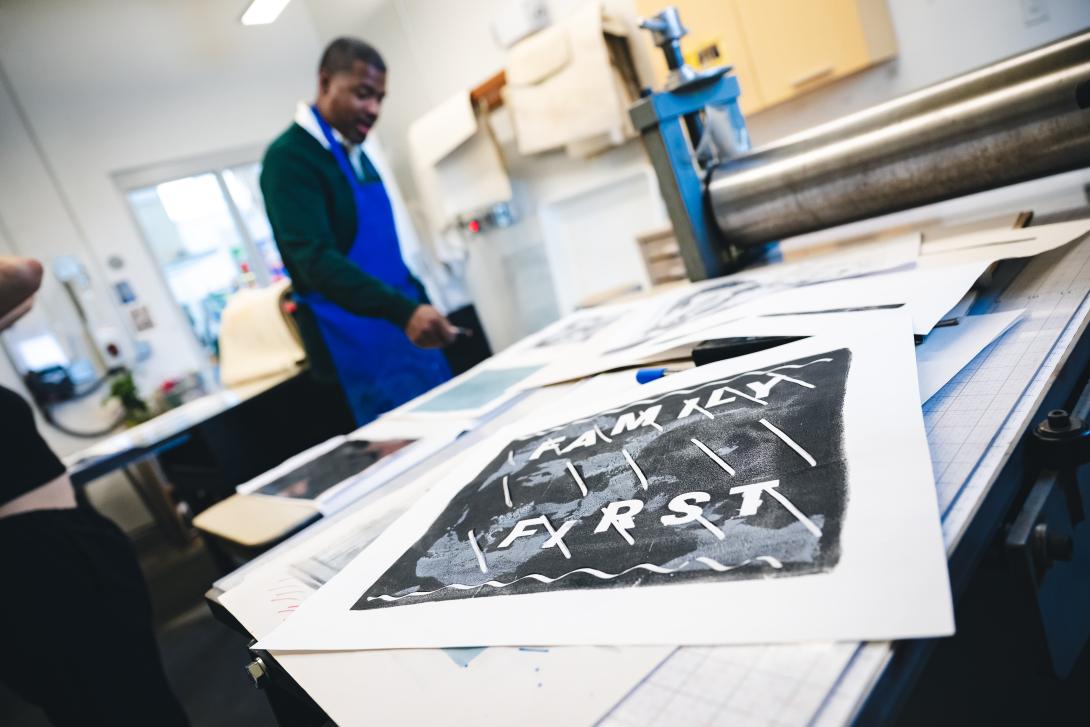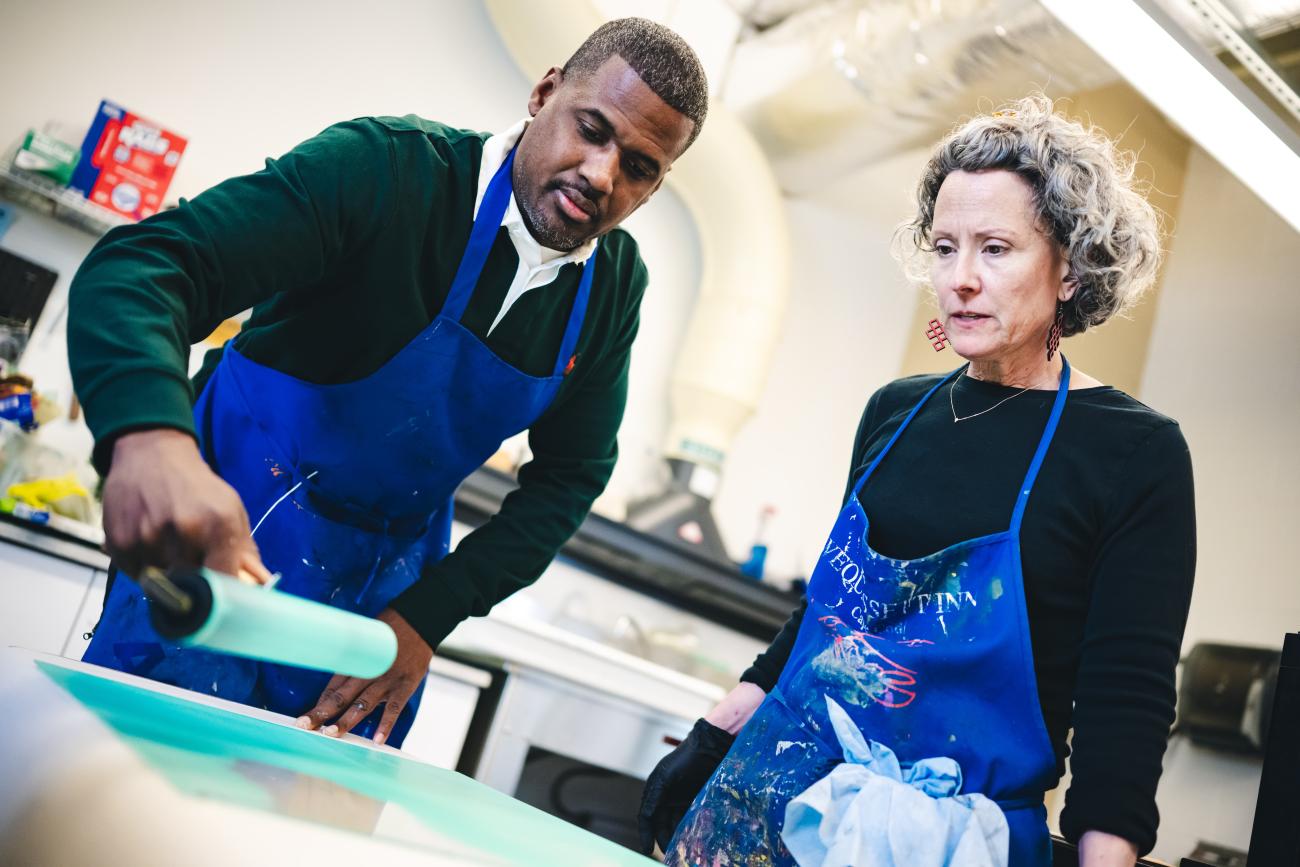The Art of the Matter
HGTV Star and Entrepreneur Chris LaMont Returns to Lehigh To Study Printmaking
Chris LaMont has mastered the art of home building since leaving Lehigh. But it was his desire to study a different artform that led him to return to campus for the first time in 18 years. LaMont spent two days at the Mountaintop Campus in April to complete an intensive five-hour workshop learning the basics of printmaking with Deirdre Murphy, teaching assistant professor in Art, Architecture and Design.
With his brother Calvin – also an alumnus – LaMont cohosts HGTV’s “Buy It or Build It,” and runs Volume Income Properties (VIP), which builds entry-level and workforce housing in Dallas, Texas. His entrepreneurial success has allowed him to pursue an interest in collecting art. What initially began as an investment has blossomed into advocating for emerging artists whose work he collects – and with that has come a desire to learn more about how art is created.
“As I continue to learn about art, it’s about more than collecting,” states LaMont, who studied supply chain management at Lehigh. “To me, art is like a social referendum on people’s lives and how they see (their lives).”
Art was never an interest during his years at Lehigh, where he and his brother played football. LaMont was inspired to begin collecting it after connecting with The Green Family Art Foundation and its founder, Eric Green. The foundation plays an integral role in promoting under-represented artists in Dallas. LaMont has since acquired nearly 40 works produced by minority artists. “Most of the art I collect is from the African Diaspora, black Americans and other minorities,” he says. “They are living artists for the most part.”
While following Lehigh’s Instagram account, LaMont saw a post featuring Murphy’s work, including prints created using images from the Trembley Herbarium. The project is supported by CORE (Collaborative Research Opportunity) grant she received with photographer Anna Chupa, professor of art and design and Louis and Jane P. Weinstock ’36 Chair of Art and Architecture. Inspired by Murphy’s work, LaMont sent a message through the social media platform asking if he could study with her.
“I wanted to learn about the art of making a print and what makes a certain print more valuable than another,” LaMont says. “What makes prints more personal and unique than other prints?”
In April, he spent two days on campus that included a tour of studios in the Department of Art, Architecture and Design, a one-on-one printmaking workshop with Murphy, and meetings with students.
LaMont’s first day was spent getting re-acquainted with the campus he left nearly two decades ago, including touring Iacocca Hall and the Small Cities Lab. LaMont says he was particularly impressed with the growth of the Department of Art, Architecture and Design, noting, “The (Mountaintop Campus) is an entire area of the university that wasn’t even there (when I was at Lehigh). It’s huge: a school in itself!”
Design major Marcus Smith ’25 served as LaMont’s tour guide and accompanied him to meetings with students in AAD and Umoja House. Smith says, “If there is one thing I can say about Chris’s visit, it’s that he brought the real to campus.” In sharing his own story of building a business from the ground up, Smith says LaMont encouraged students to follow their own paths. “Entrepreneurship, at the end of the day, is just hard work and it's just adapting. And hearing that from him personally was extremely validating,” Smith says.
LaMont took inspiration from the students as he observed their intense focus on their work. “That’s why I love art,” LaMont says. “It allows you to fall into it. You forget about other things, you forget about time, and you focus on what you’re trying to do with your art.”
He did that himself during his second day on campus. To compress what usually would be days to teach printmaking into a five-hour workshop, Murphy and print shop monitors Consuelo Zapata ’25 and Megan Rodriguez ’25 prepared paper, mixed inks, and readied the studio so that LaMont could immediately begin work. “We were basically two sous chefs and a head chef,” Murphy says.

Because LaMont is committed to promoting the work of Black artists, Murphy selected examples for him to emulate that mirror his interest. Adam Pendleton, a painter who uses spray paint, brush and silkscreen processes and who incorporates text in his work, served as inspiration for one of the prints that LaMont created.
LaMont incorporated the words “Family First” to create a monoprint that included a photo of him with his 6-year-old son Jaden. His choice of a subject resonated with Zapata, a design major from El Paso, Texas. “I thought that his theme was really beautiful,” she says, adding, “Chris really embodied being an entrepreneur, but I was impressed that he was able to understand the creative art-making process and take it as a welcome challenge and make something beautiful with it.”
“He was a fantastic student,” Murphy says. “You can tell Chris is no stranger to hard work. He just rolled up his sleeves, put on an apron, and got right in there. He was a very fast learner. He was open to collaboration and on-the-fly critical analysis (when I gave him tips) like ‘What if you move this here?’ or ‘How about if we mix a color like this?’ …I told him, ‘You’re going to get an A plus for this workshop.’ ”
In addition to the monoprint featuring his son, LaMont completed a second print using stencils and a French etching press.
LaMont says Murphy made the process both enjoyable and informative. “I’m so very grateful to her,” he says. “I’m just happy to get firsthand knowledge about printmaking….I’m more appreciative now if I see a piece from a superstar artist and they say it has 22 layers. Now I know what that means.”
He says his visit has sparked an interest in establishing continued involvement in Lehigh’s Art, Architecture and Design program and with the Lehigh University Art Galleries. LaMont would welcome the chance to work with his alma mater to promote the work of minority artists, asking what for him is a key question: “How do we make it more inclusive?”

